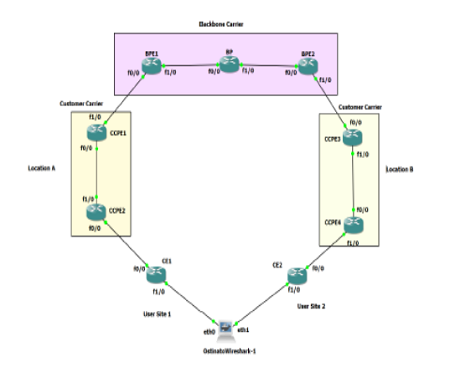


Indian Journal of Science and Technology
DOI: 10.17485/IJST/v16i46.2456
Year: 2023, Volume: 16, Issue: 46, Pages: 4445-4455
Original Article
Merline Johndoss1*, T Pramananda Perumal1
1Presidency College, Chennai, 600 005, Tamil Nadu, India
*Corresponding Author
Email: [email protected]
Received Date:28 September 2023, Accepted Date:18 October 2023, Published Date:20 December 2023
Objectives: A small service provider intends to connect its customers who are geographically apart and to give Multi Protocol Label Switching-Virtual Private Networks (MPLS-VPNs) services. But, the small service provider does not have direct connectivity between the locations. The end customers want very secure, fast and scalable network connectivity. To provide the requirements of the end customers, a comprehensive solution viz. Carrier supporting Carrier (CsC) network model is proposed. Methods: A topology for CsC network implementation is designed with Backbone Carrier routers, Customer Carrier routers and Customer routers. This CsC network is deployed with Customer Carrier providing MPLS-VPN services to its customers. MPLS is built on both Customer Carrier and Backbone Carrier service providers’ IP networks. Interior Gateway Protocols (IGPs) are run for ensuring reachability. Over these IP networks, MPLS and Label Distribution Protocol (LDP) are run and the packets are switched using labels. VPNs are provided by using the concept of Virtual Routing and Forwarding (VRF) and using Multi Protocol-interior Border Gateway Protocol (MP-iBGP). By using MP-iBGP, it is ensured that the service providers’ core routers are BGP free and the labelled packets from Customer Carrier is taken across Backbone Carrier. Findings: The proposed method is simulated using GNS3 network simulator. Carrier supporting Carrier topology is deployed in the GNS3 simulator and reachability from Customer PC of user site-1 to Customer PC of user site-2 is tested using ICMP ping command. It is successful. Also, traffic generator tool Ostinato is used to generate TCP and UDP traffic. Additionally, Wireshark, a network Monitoring and Analysing tool, is used to analyse the performance of the CsC network. From the deployed CsC topology and its implementation, it is found that MPLS-VPN services, provided by the Customer Carrier to its customers, are working fine. In the performance analysis of the CsC network using ICMP Extended ping command, it is seen that the average round trip time is around 240 ms which shows that Carrier supporting Carrier is working fine and consistent. Additionally, in UDP transmission, it is observed that on an average 1250 packets per second are transmitted and received and the average transmitted bit rate and received bit rate are 380 bits/second. In TCP transmission, it is observed that on an average of 1000 packets per second are transmitted and received per second and the average throughput is 35 Mbps. Hence, UDP and TCP traffic transmissions confirm the consistency and performance accuracy of the proposed model. Novelty: In the Telecommunication Networks, currently IP based inter-Autonomous System (AS) routing is used. Conventionally, IP based routing faces lots of challenges in providing enhanced and scalable services. By implementing CsC, inter-AS MPLS-VPNs are provided through label exchanging method in order to switch labelled packets. There are three ways of exchanging labels in a MPLS VPN networks viz. i) using IGP+LDP, ii) using BGP and iii) BGP-LU. In this study, deployment of CsC is done through IGP+LDP label exchange method. By adopting and optimising the CsC model, labelled packets can be switched/forwarded across both of the AS networks. This CsC model adds value to next generation 5G networks which include networks densification, capacity expansion and rural coverage.
Keywords: MPLS Label, VRF, LDP, CsC, MPLS-VPN
© 2023 Johndoss & Perumal. This is an open-access article distributed under the terms of the Creative Commons Attribution License, which permits unrestricted use, distribution, and reproduction in any medium, provided the original author and source are credited. Published By Indian Society for Education and Environment (iSee)
Subscribe now for latest articles and news.